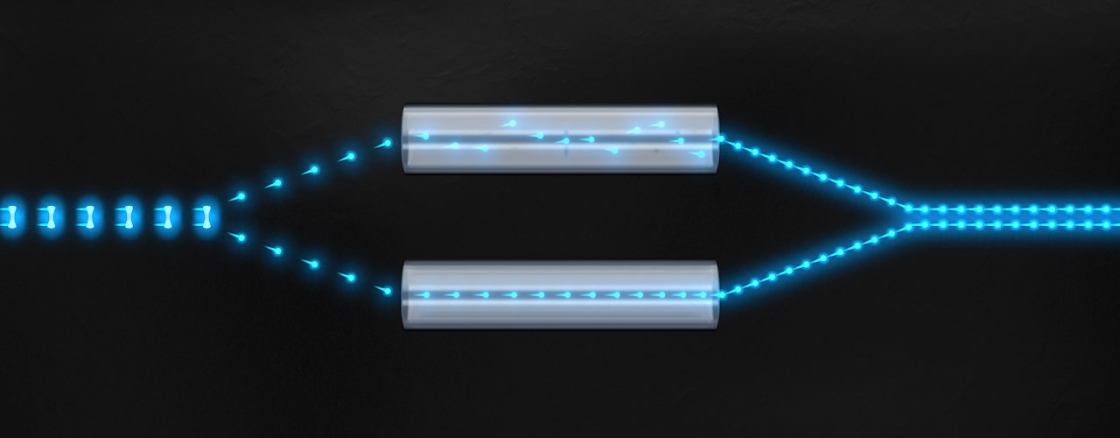Physicists study many forms of communication, including quantum communication. Thanks to specific properties of quantum mechanics, like entanglement, information integrity can be better maintained with quantum communications, even being hackproof in some cases. Quantum entanglement is the property that allows two molecules, each in a random quantum state, to be in perfect harmony with each other. This is important, as one common test of quantum communication devices, a.k.a., quantum channels, is to send entangled photons (light particles) down these channels. Entanglement helps when photons are lost or absorbed, as the redundancy in information being sent this way ensures that some of the information will still reach the receiver.
Quantum channels have their own quirks that make them unique to study. In a new paper published in Nature Communications, post-doctoral researcher Vikesh Siddhu of JILA Fellow Graeme Smith's team looked at some of the logistics in using quantum channels to send information. Siddhu analyzed how noise occurring in a quantum channel affects the information it communicates. “Noise in the quantum channel world is essentially coming from interaction with an environment you don't control," Siddhu explained. And since you don't control it, what you're trying to send becomes noisy.”
Using noise as a factor, Siddhu theorized new reasonings for “synergy” between two quantum channels. Synergy refers to an interaction that results in a sum that is greater than the simple sum of its parts. Synergy, Siddhu added, can occur when the two channels work together to send information. “In this case, Channel A can’t send any information on its own, but when used in conjunction with the other channel, Channel B, it becomes useful,” Siddhu clarified. “Channel B, on the other hand, can send information on its own, but when it gets combined with the seemingly useless Channel A, it can send even more information.” Common sense would suggest that the useless channel would negatively affect the transmission of quantum information, but Siddhu found it was quite the opposite.
In his paper, Siddhu described this puzzling behavior as “non-additive.” As Siddhu explained: “Ordinarily, the amount of information coming out from two channels is at most the sum of information that can be sent by each channel. Non-additivity shows us that when quantum channels are used together, they can send more information than each channel sends on its own.”
The Next Steps
To further understand non-additivity, Siddhu wants to look more closely at the role of entanglement. It is possible, he says, that entanglement could boost synergy between two channels, making them more effective at sending information than if the channels were not entangled. In such a case, not only would the channels behave strangely, working better together than separately, but entanglement could increase the efficiency of the transmission even more.
From this analysis Siddhu realized that there was clearly more to learn from the quantum channels and their behaviors with entangled photons. Understanding how quantum channels behave is key to developing and fine-tuning a quantum communication system. Siddhu is hoping to better understand the interactions between these two quantum channels as well as the non-additive behaviors of the channels. With this knowledge, Siddhu and other researchers can work to develop more efficient ways of communicating quantum information and increase understanding of quantum mechanics.
Written by Kenna Castleberry, JILA Science Communicator



 The Physics Frontiers Centers (PFC) program supports university-based centers and institutes where the collective efforts of a larger group of individuals can enable transformational advances in the most promising research areas. The program is designed to foster major breakthroughs at the intellectual frontiers of physics by providing needed resources such as combinations of talents, skills, disciplines, and/or specialized infrastructure, not usually available to individual investigators or small groups, in an environment in which the collective efforts of the larger group can be shown to be seminal to promoting significant progress in the science and the education of students. PFCs also include creative, substantive activities aimed at enhancing education, broadening participation of traditionally underrepresented groups, and outreach to the scientific community and general public.
The Physics Frontiers Centers (PFC) program supports university-based centers and institutes where the collective efforts of a larger group of individuals can enable transformational advances in the most promising research areas. The program is designed to foster major breakthroughs at the intellectual frontiers of physics by providing needed resources such as combinations of talents, skills, disciplines, and/or specialized infrastructure, not usually available to individual investigators or small groups, in an environment in which the collective efforts of the larger group can be shown to be seminal to promoting significant progress in the science and the education of students. PFCs also include creative, substantive activities aimed at enhancing education, broadening participation of traditionally underrepresented groups, and outreach to the scientific community and general public.